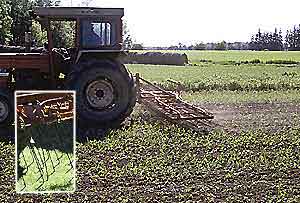Mechanical control of weed seedlings
Weeds, particularly annual weeds produce a lot of small seeds and they have a high degree of dormancy. In a given year, fewer than 10% of the viable seeds will germinate, and some will persist in a dormant state for 10 and some to even hundreds of years. This characteristic minimizes the risk of local extinction that might occur if all of the seeds germinated at once. In contrast seeds of grain crops have been selected for size rather than number, and there is little if any dormancy. Humans minimize the risk to the crop species by planting the seeds when conditions are most suitable, and nursing them in various ways subsequently.
Most weed seeds require exposure to light to germinate - otherwise, if a small seed germinated deep in the soil, it would not have enough energy to get to the surface. Thus in a given year, only seeds in the top few millimeters of soil germinate. Because they are relatively large, the crop seeds can be planted deeper in the soil (e.g. 2.5 to 4 cm for a grain crop, deeper for crops like beans and peas), which provides better moisture and access to nutrients than if they are planted right at the surface.
Differences in the ecology of weeds and crops are exploited in mechanical control of weeds. First, by disturbing the soil in spring, the weed seeds in the surface are exposed to light which stimulates germination; once they have germinated, they can be readily uprooted by use of a harrow or similar device. The harrow scratches the surface of the soil as you might do with a fan rake. Then the crop is planted into a clean seedbed. After the crop has germinated and grown a bit, another harrowing will remove the second flush of weeds; the harrowing has relatively little effect on the crop plants because they are well and deeply rooted. After that, the crop quickly establishes a closed canopy and any subsequent germination and growth of weeds is strongly light limited. An important benefit of this approach (versus herbicides) is that it allows a diverse weed population to be maintained in the field with benefits for pest control wildlife and conservation of genetic diversity for crops (Links are to other vignettes. )

Here a device called a Finger Weeder is being used to remove or set back weeds in a pea crop.

A profile showing rooting of fababeans at 18 days
after planting, and weeds which germinated near the surface. The crop clearly has the advantage here.